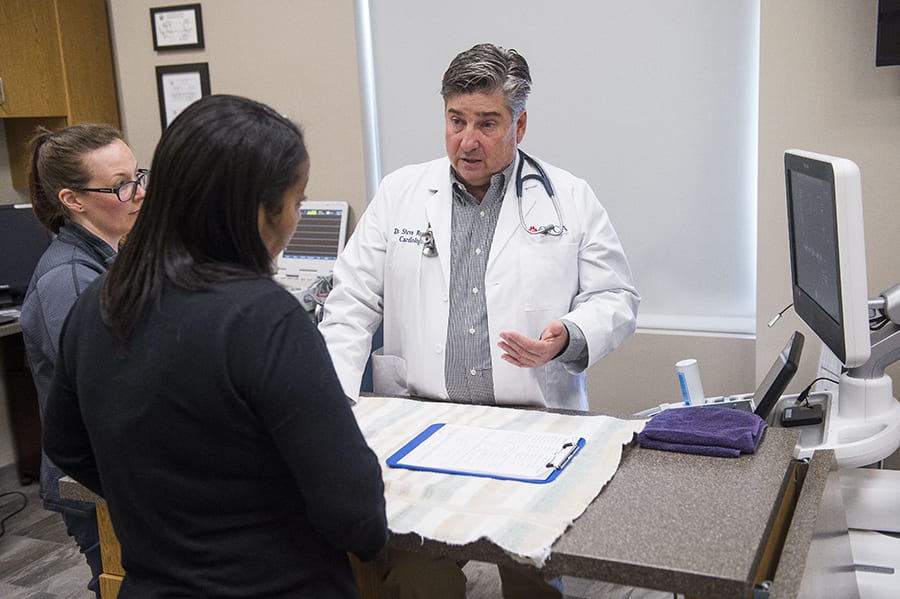Why CT Scans For Animals Are Becoming Standard in Modern Veterinary Medicine}
Wiki Article
Exploring the Vital Services Used by a Veterinary Cardiologist: Comprehending Ultrasound and CT Scan Strategies
Veterinary cardiologists play an important duty in the health and wellness of pet dogs by diagnosing and dealing with different heart disease. They make use of sophisticated imaging techniques, such as cardiac ultrasound and CT scans, to provide precise evaluations. Each technique has its unique advantages and applications. Understanding these methods is necessary for pet proprietors seeking the best look after their buddies. What factors should pet dog owners take into consideration when choosing in between these analysis devices?
The Role of Vet Cardiologists in Pet Health Care
Vet cardiologists play an essential role in the medical care of pets, focusing particularly on diagnosing and dealing with heart-related problems. They possess specialized training that enables them to translate complex diagnostic tests and identify different cardio concerns. These specialists utilize innovative methods, such as echocardiography and electrocardiography, to evaluate heart function and structure accurately.Veterinary cardiologists additionally create tailored treatment plans that might include drugs, way of life alterations, and, in many cases, medical treatments. Their experience encompasses enlightening family pet owners regarding heart health and wellness, stressing the importance of routine check-ups and very early detection of possible issues. Partnership with basic veterinarians is important, as it ensures detailed look after pet dogs with believed heart problems. By providing specialized services, vet cardiologists greatly improve the high quality of life for animals and give comfort for their proprietors, strengthening the significance of heart health in total pet wellness.Usual Heart Concerns in Family Pets
Common heart problems in family pets can greatly influence their health and wellness and high quality of life. Heart whisperings, different kinds of cardiomyopathy, and hereditary heart flaws are amongst the most widespread conditions that vets experience. Cancer Veterinary Near Me. Recognizing these problems is important for pet dog owners to assure timely medical diagnosis and suitable therapyHeart Murmurs in Pets
Although heart whisperings can be a source of worry for pet proprietors, they are not constantly a measure of severe health concerns. A heart murmur is an irregular sound created by stormy blood flow within the heart. In family pets, these whisperings can be caused by numerous variables, including hereditary heart defects, valve problems, or also anxiety throughout examinations. Several animals with heart murmurs lead regular lives without significant health and wellness effects. To determine the underlying cause, vet cardiologists often employ diagnostic methods such as echocardiograms and Doppler ultrasounds. Early discovery and assessment are necessary, as they might aid manage any prospective cardiac problems effectively. Animal owners are motivated to consult their vet for a thorough examination if a heart whispering is spotted.Cardiomyopathy Types Explained
Cardiomyopathy includes a group of illness impacting the heart muscular tissue, bring about endangered heart feature in pet dogs. One of the most common types include dilated cardiomyopathy (DCM), hypertrophic cardiomyopathy (HCM), and limiting cardiomyopathy (RCM) DCM largely influences pets, creating the heart to enlarge and deteriorate, which diminishes its capability to pump blood effectively. On the other hand, HCM is more prevalent in pet cats, identified by the enlarging of the heart walls, typically leading to obstructed blood circulation. RCM, though much less typical, occurs when the heart muscle comes to be inflexible, restricting its capability to full of blood. Each kind provides distinct challenges in medical diagnosis and therapy, necessitating specialized vet cardiological examination to ensure peak management and treatment for impacted pets.Genetic Heart Flaws
Genetic heart defects represent a substantial group of cardiac concerns in family pets, distinctive from gotten problems such as cardiomyopathy - Board Certified Veterinary Cardiologist. These defects are architectural abnormalities existing at birth, affecting the heart's typical function. Usual types consist of patent ductus arteriosus, ventricular septal issues, and pulmonic stenosis. Signs and symptoms may differ widely, varying from mild to serious, and can consist of exercise intolerance, coughing, and trouble breathing. Early diagnosis with advanced imaging methods like ultrasound is crucial for efficient monitoring. Veterinary cardiologists play a vital role in recognizing these problems and recommending ideal treatment choices, which might consist of medical administration or medical intervention. Acknowledging congenital heart problems permits better outcomes and improved lifestyle for affected animalsRecognizing Cardiac Ultrasound: Exactly How It Functions
A substantial number of veterinary methods currently make use of heart ultrasound as a vital analysis device for evaluating heart health in animals. This non-invasive method makes use of high-frequency audio waves to produce photos of the heart's structure and function. During the treatment, a vet technician applies a gel to the pet's breast and makes use of a transducer to release ultrasound waves. These waves jump off the heart and bordering frameworks, creating real-time photos on a monitor.Veterinarians can assess various aspects of cardiac health, including chamber size, wall activity, and shutoff feature. Furthermore, cardiac ultrasound allows for the detection of abnormalities such as fluid accumulation and congenital heart problems. This technique is vital for detecting problems that might not be noticeable via standard radiographs. By supplying thorough details regarding the heart's composition and performance, cardiac ultrasound help in developing reliable therapy strategies for animals struggling with cardiovascular disease.The Relevance of CT Checks in Diagnosing Heart Issues
Just how do CT scans improve the diagnosis of heart disease in veterinary medicine? CT scans give thorough cross-sectional photos of the heart and surrounding structures, permitting vets to imagine intricate physiological relationships. This imaging strategy is especially useful in identifying genetic heart problems, cardiac growths, and abnormalities in capillary. By using innovative imaging algorithms, CT scans can assess heart chamber dimensions and function, offering a detailed view that might be challenging to attain with standard methods.Additionally, CT angiography can visualize blood flow and determine areas click resources of constriction or obstruction, which is crucial for preparing possible interventions. The speed and accuracy of CT scans also assist in quick diagnoses, crucial in emergency situation situations. Inevitably, the unification of CT scans into vet cardiology considerably enhances the precision of diagnoses, allowing targeted therapy plans and boosting patient end results for pets suffering from heart conditions.Contrasting Ultrasound and CT Scan Strategies
While both ultrasound and CT scans are indispensable devices in veterinary cardiology, they provide unique benefits and constraints that influence their use in identifying heart disease. Ultrasound, or echocardiography, provides real-time imaging of the heart's structure and function, enabling vets to analyze heart chambers, shutoffs, and blood circulation. It is specifically effective for assessing problems like coronary infarction and cardiomyopathy. However, ultrasound might be restricted in imagining particular anatomical frameworks due to patient size or obesity.In contrast, CT checks offer in-depth cross-sectional pictures of the heart and surrounding tissues, making them optimal for determining architectural irregularities, growths, or vascular concerns. Although CT scans provide thorough understandings, they call for sedation and might include radiation direct exposure. Inevitably, the option between ultrasound and CT checks depends on the specific clinical circumstance, the client's condition, and the details required for an exact diagnosis.Therapy Choices Offered Via Vet Cardiology
Vet cardiology provides a variety of treatment choices tailored to address different heart disease in animals. Therapy strategies often start with lifestyle alterations, consisting of diet plan adjustments and workout adjustments, targeted at enhancing total heart wellness. Drugs play a vital role, with cardiologists recommending drugs such as diuretics, beta-blockers, and ACE preventions to handle symptoms and boost heart function.In more serious instances, interventional procedures, such as balloon valvuloplasty or stent positioning, may be necessary to ease blockages or boost blood flow. For certain hereditary heart defects, surgical alternatives may be checked out to deal with structural problems. Furthermore, ongoing monitoring and follow-up care are crucial components of a thorough treatment strategy, permitting prompt adjustments based upon the pet dog's action to therapy. On the whole, vet cardiology concentrates on supplying reliable, individualized care to maximize the health and wellness and health of pet clients with heart problems.How to Prepare Your Pet Dog for a Cardiac Assessment
Preparing a pet dog for a heart assessment is vital to ensure exact results and a smooth process. Owners must initially arrange the consultation with the vet cardiologist and review any kind of details demands or problems. It is a good idea to keep food for a minimum of 12 hours before the examination, as this aids boost imaging top quality during treatments like ultrasound or CT scans.Additionally, preserving a calm atmosphere on the day of the appointment can help reduce the family pet's anxiety. It is beneficial to bring along any type of relevant clinical documents, consisting of previous tests and medications (Ultrasound For Dogs). Proprietors need to likewise make sure that their family pet fits and leashed during transport to the facility. Finally, familiarizing themselves with the analysis procedure can ease concerns and assist in asking informed inquiries during the appointment. By following these actions, owners can add greatly to the performance of the cardiac analysisFrequently Asked Inquiries
The length of time Does a Heart Ultrasound or CT Scan Take?
The period of a cardiac ultrasound typically ranges from 30 to 60 mins, while a CT scan might take approximately 15 to 30 mins. Factors such as the individual's condition can influence these time price quotes.
Exist Any Risks Related To These Analysis Treatments?

Can I Stay With My Pet Throughout the Treatment?
The vet center's policy normally dictates whether animal owners can remain during procedures. While some clinics urge proprietor existence for comfort, others may call for splitting up to ensure security and suitable problems for diagnostic imaging.Just how much Do These Diagnostic Examinations Normally Expense?
The costs of diagnostic tests, such as ultrasound and CT scans, generally differ based upon area and center. Usually, prices vary from a couple of hundred to over a thousand bucks, mirroring the intricacy and modern technology entailed.
What Is the Recovery Process After a Heart Evaluation?
The recuperation procedure after a heart assessment involves monitoring the animal for any prompt responses, making certain comfort, and restricting physical activity. Vets usually provide post-evaluation directions to direct pet owners throughout this vital recuperation duration. Heart murmurs, numerous types of cardiomyopathy, and hereditary heart defects are among the most widespread conditions that vets experience. A heart whispering is an uncommon noise generated by turbulent blood circulation within the heart. Cardiomyopathy incorporates a group of illness affecting the heart muscle mass, leading to useful reference endangered cardiac feature in my company pets. Hereditary heart issues represent a substantial classification of cardiac issues in family pets, distinctive from acquired problems such as cardiomyopathy. Ultrasound, or echocardiography, provides real-time imaging of the heart's structure and feature, allowing veterinarians to analyze heart chambers, valves, and blood flow.Report this wiki page